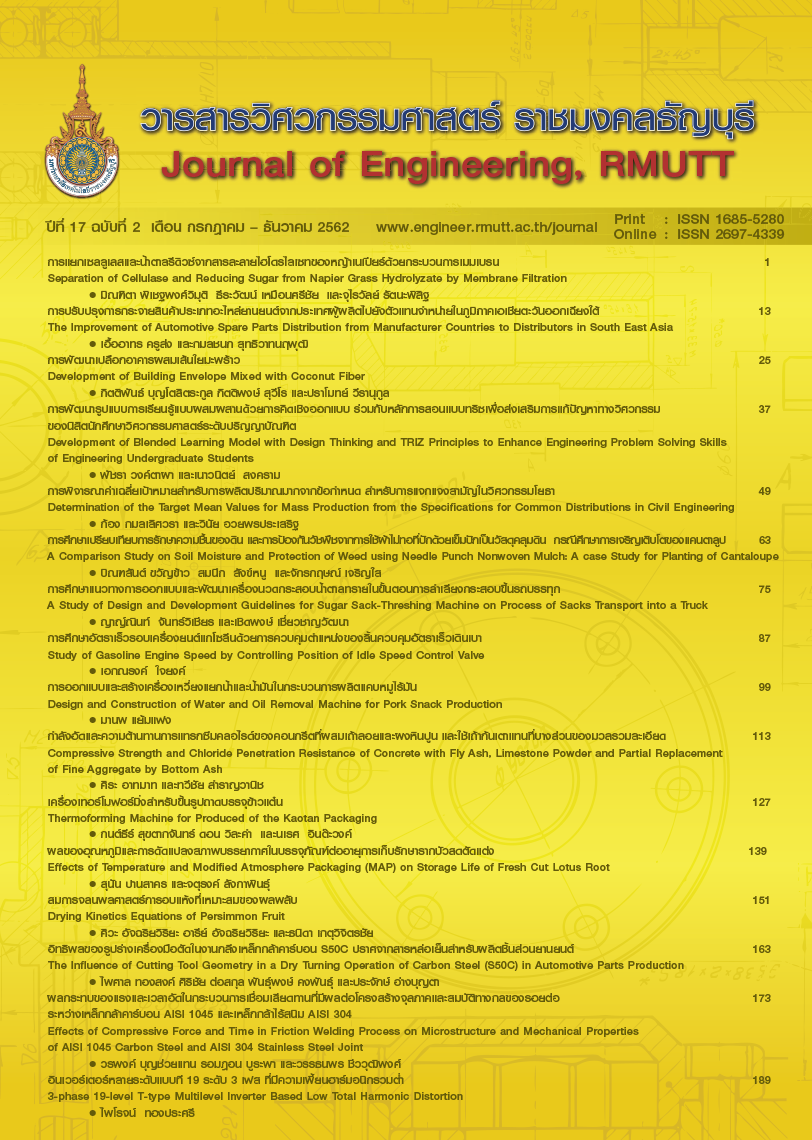A Comparison Study on Soil Moisture and Protection of Weed using Mulch Needle Punch Nonwoven: A case study for planting of cantaloupe
Main Article Content
Abstract
Mulching is mainly help in conserving of soil moisture and also reducing weed growth in cultivation area. Nowadays materials that are used as mulching are varied to natural materials, synthesis materials, and agricultural textile materials such as nonwoven mulching. In this study, polyester fiber is developed into mulching by needle-punched nonwoven technic with four sizes of samples including nonwoven fabric (A) size 47 g/m2 thickness 0.28 mm., nonwoven fabric (B) size 105 g/m2 thickness 0.90 mm., nonwoven fabric (C) size 155 g/m2 thickness 1.27 mm. and nonwoven fabric (D) size 210 g/m2 thickness 2.62 mm. Strength test are conducted on four samples. It is founded that sample C has the highest strength; while sample A and sample D are not capable of the test due to its thickness, too thin and too thick respectively. Moreover, all four samples are studied on cantaloupe cultivation as mulching, comparing to another three cultivations with different mulching: no mulching, plastic sheet mulching, and rice straw mulching. The results show that cultivation using sample D is well conserve of soil moisture, has less weeds, and can grow strong cantaloupe. Sizes of fruits and leaf from sample D cultivation are also good comparing to other cultivations.
Article Details
The manuscript, information, content, picture and so forth which were published on Frontiers in engineering innovation research has been a copyright of this journal only. There is not allow anyone or any organize to duplicate all content or some document for unethical publication.
References
Deng L, Wang K, Li J, Zhao G, Shangguan Z. Effect of soil moisture and atmospheric humidity on both plant productivity and diversity of native grasslands across the Loess Plateau, China. Ecological Engineering. 2016;(94):525-31.
Paul, J. Kramer. Soil Moisture in Relation to Plant Growth. The Botanical Review. 1944(9):525-559.
Kyriacou MC, Leskovar DI, Colla G, Rouphael Y. Watermelon and melon fruit quality: The genotypic and agro-environmental factors implicated. Scientia Horticulturae. 2018;(234):393-408.
Kyrikou I, Briassoulis D. Biodegradation of Agricultural Plastic Films: A Critical Review. Journal of Polymers and the Environment. 2007;15(3):227-.
Heisler-White JL, Knapp AK, Kelly EF. Increasing precipitation event size increases aboveground net primary productivity in a semi-arid grassland. Oecologia. 2008;158(1):129-40.
C. PDP, Jin Y, E. SO, P. AJ. Directional climate change and potential reversal of desertification in arid and semiarid ecosystems. Global Change Biology. 2012;18(1):151-63.
Rukkla [Internet]. ; 2017. The manual of melon plant; 2018 [22 Apr 2018]; [about 1 p.] from: https://www.rukkla.com/content/1 0739/คู่มือการปลูกแคนตาลูป. (in Thai)
Sanook [Internet].; 2015. New generation and Super rich Melon;2018 [22 Apr 2018]; [about 1 p.]; [about 1 p.] from:http://money.sanook.com/260137. (In Thai).
Chalker-Scott L. Impact of Mulches on Landscape Plants and the Environment — A Review. Journal of Environmental Horticulture. 2007;25(4):239-49.
Xiangwu, Z. Fundamentals of Fiber Science. 1st ed. Pensylvania: Destech Publication, Inc; 2014
Weerasak Udomkeasy. Fiber since. 1st ed. Bangkok: Chulalongkorn University Printing House;1999. (In Thai)
Russell SJ, Smith PA. 6 - Technical fabric structures – 3. Nonwoven fabrics A2 - Horrocks, A. Richard. In: Anand SC, editor. Handbook of Technical Textiles (Second Edition): Woodhead Publishing; 2016. p. 163-88.
Zribi W, Aragüés R, Medina E, Faci JM. Efficiency of inorganic and organic mulching materials for soil evaporation control. Soil and Tillage Research. 2015;148:40-5.
Kader MA, Senge M, Mojid MA, Ito K. Recent advances in mulching materials and methods for modifying soil environment. Soil and Tillage Research. 2017;168:155-66.
Abd El-Mageed TA, Semida WM, Abd El-Wahed MH. Effect of mulching on plant water status, soil salinity and yield of squash under summer-fall deficit irrigation in salt affected soil. Agricultural Water Management. 2016;173:1-12.


